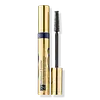Maybelline Great Lash Washable Mascara Versus Estée Lauder Sumptuous Extreme Lash Multiplying Volume Mascara
What's inside
What's inside
 Key Ingredients
Key Ingredients

No key ingredients
 Benefits
Benefits

 Concerns
Concerns

 Ingredients Side-by-side
Ingredients Side-by-side

Water
Skin ConditioningBeeswax
Emulsion StabilisingOzokerite
Emulsion StabilisingShellac
EmollientGlyceryl Stearate
EmollientTriethanolamine
BufferingPropylene Glycol
HumectantStearic Acid
CleansingSorbitan Sesquioleate
EmulsifyingMethylparaben
PreservativeQuaternium-15
PreservativeQuaternium-22
Simethicone
EmollientButylparaben
MaskingIron Oxides
CI 77891
Cosmetic ColorantCI 77007
Cosmetic ColorantMica
Cosmetic ColorantWater
Skin ConditioningStearic Acid
CleansingMyrica Cerifera Fruit Wax
EmollientSucrose Polybehenate
EmollientPolyisobutene
Polyvinyl Acetate
Emulsion StabilisingParaffin
PerfumingAminomethyl Propanediol
BufferingIsostearic Acid
CleansingSilica
AbrasivePanthenol
Skin ConditioningPantethine
EmollientCopernicia Cerifera Wax
Kaolin
AbrasiveHydroxyethylcellulose
Emulsion StabilisingCholesterol
EmollientHydrogenated Olive Oil
Skin ConditioningPtfe
Vp/Eicosene Copolymer
Olea Europaea Fruit Oil
MaskingOlea Europaea Oil Unsaponifiables
Skin ConditioningSodium Polyacrylate
AbsorbentRosmarinus Officinalis Leaf Extract
AntimicrobialSimethicone
EmollientPolyester-5
Pvp
Emulsion StabilisingCaprylyl Glycol
EmollientHexylene Glycol
EmulsifyingNylon-6
Laureth-4
EmulsifyingPolyethylene Terephthalate
Nylon-66
Synthetic Fluorphlogopite
Chlorphenesin
AntimicrobialPhenoxyethanol
PreservativeCI 77891
Cosmetic ColorantMica
Cosmetic ColorantCI 77491
Cosmetic ColorantCI 77492
Cosmetic ColorantCI 77499
Cosmetic ColorantCI 77266
Cosmetic ColorantCI 77510
Cosmetic ColorantCI 42090
Cosmetic ColorantCI 77007
Cosmetic ColorantCI 19140
Cosmetic ColorantCI 77163
Cosmetic ColorantCI 75470
Cosmetic ColorantCI 77289
Cosmetic ColorantCI 77288
Cosmetic ColorantWater, Stearic Acid, Myrica Cerifera Fruit Wax, Sucrose Polybehenate, Polyisobutene, Polyvinyl Acetate, Paraffin, Aminomethyl Propanediol, Isostearic Acid, Silica, Panthenol, Pantethine, Copernicia Cerifera Wax, Kaolin, Hydroxyethylcellulose, Cholesterol, Hydrogenated Olive Oil, Ptfe, Vp/Eicosene Copolymer, Olea Europaea Fruit Oil, Olea Europaea Oil Unsaponifiables, Sodium Polyacrylate, Rosmarinus Officinalis Leaf Extract, Simethicone, Polyester-5, Pvp, Caprylyl Glycol, Hexylene Glycol, Nylon-6, Laureth-4, Polyethylene Terephthalate, Nylon-66, Synthetic Fluorphlogopite, Chlorphenesin, Phenoxyethanol, CI 77891, Mica, CI 77491, CI 77492, CI 77499, CI 77266, CI 77510, CI 42090, CI 77007, CI 19140, CI 77163, CI 75470, CI 77289, CI 77288
Ingredients Explained
These ingredients are found in both products.
Ingredients higher up in an ingredient list are typically present in a larger amount.
This pigment is called Ultramarine blue lazurite. It gives a saturated blue color, but can be used to create other colors as well.
According to the manufacturer, it is usually made from kaolin, sodium sulfate, sodium carbonate, sulfur, and charcoal.
Ci 77891 is a white pigment from Titanium dioxide. It is naturally found in minerals such as rutile and ilmenite.
It's main function is to add a white color to cosmetics. It can also be mixed with other colors to create different shades.
Ci 77891 is commonly found in sunscreens due to its ability to block UV rays.
Learn more about CI 77891Mica is a naturally occurring mineral used to add shimmer and color in cosmetics. It can also help improve the texture of a product or give it an opaque, white/silver color.
Serecite is the name for very fine but ragged grains of mica.
This ingredient is often coated with metal oxides like titanium dioxide. Trace amounts of heavy metals may be found in mica, but these metals are not harmful in our personal products.
Mica has been used since prehistoric times throughout the world. Ancient Egyptian, Indian, Greek, Roman, Aztec, and Chinese civilizations have used mica.
Learn more about MicaSimethicone is a silicone. It is an emollient and used to reduce foaming in a product. It is also often used to coat sunscreen ingredients for better spreadability.
This ingredient is created by mixing dimethylpolysiloxane and hydrated silica.
Stearic Acid is a fatty acid. It is an emollient, emulsifier, and texture enhancer.
As an emollient, stearic acid helps soften skin. It aids the skin's protective barrier by preventing water loss. It also provides a gentle cleansing effect without stripping away natural oils.
Stearic acid may also be used to enhance the texture of products. It can add volume and stabilize ingredients such as water and oil. This can help water and oil ingredients from separating.
Sources of stearic acid include animal or vegetable fats/oils such as coconut or shea. It can be naturally found in butter, cocoa butter, shea butter, vegetable fats, and animal tallow.
This ingredient may not be Malassezia folliculitis, or fungal-acne safe.
Learn more about Stearic AcidWater. It's the most common cosmetic ingredient of all. You'll usually see it at the top of ingredient lists, meaning that it makes up the largest part of the product.
So why is it so popular? Water most often acts as a solvent - this means that it helps dissolve other ingredients into the formulation.
You'll also recognize water as that liquid we all need to stay alive. If you see this, drink a glass of water. Stay hydrated!
Learn more about Water